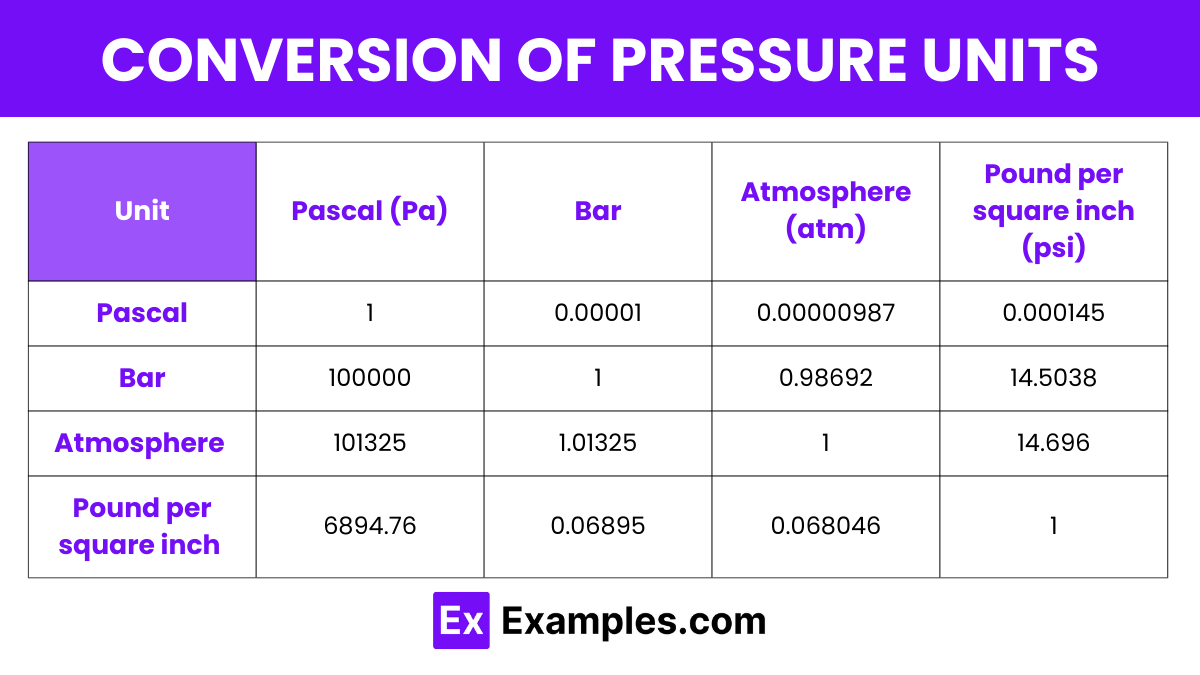What is the SI unit of pressure?
Pascal
Bar
Atmosphere
Torr


Pressure is a fundamental concept in physics, defined as the force applied per unit area. It is a critical parameter in both scientific and everyday contexts, influencing everything from weather patterns to the functionality of vehicle tires. To measure pressure, several units are utilized, each tailored to specific applications in science, industry, and engineering.
The pascal is defined as one newton per square meter (N/m²). This unit provides a direct measure of the force exerted over a specific area, making it fundamental for precise calculations in physics and engineering.
The barye is defined as one dyne per square centimeter (dyn/cm²). A dyne is the CGS unit of force, and it measures the force that would give a mass of one gram an acceleration of one centimeter per second squared.
| Unit | Symbol |
|---|---|
| Pascal | Pa |
| Bar | bar |
| Atmosphere | atm |
| Torr | Torr |
| Pound per square inch | psi |
| Barye | Ba |
The Pascal is the SI unit of pressure named after the French mathematician, physicist, and inventor Blaise Pascal. It measures the force of one newton per square meter. It is widely used in science and engineering to quantify internal pressure, stress, Young’s modulus, and tensile strength.
The bar is a metric unit of pressure, but not part of the International System of Units (SI). It is closely aligned with the atmospheric pressure of Earth and is commonly used in meteorology, oceanography, and related fields.
The atmosphere is a unit of pressure defined as being equal to the average atmospheric pressure on Earth at sea level. It is commonly used in various applications including meteorology and aviation.
1 Torr ≈ 133.322 Pa
Named after Evangelista Torricelli, an Italian physicist and mathematician, the Torr is a unit of pressure based on an earlier unit known as the millimeter of mercury (mmHg). It is primarily used in vacuum measurements.
1 psi = 6,894.76 Pa
The pound per square inch is a unit of pressure widely used in the United States and other countries still utilizing imperial standards. It measures the pressure resulting from a force of one pound-force applied to an area of one square inch.
The Barye is the CGS unit of pressure. It is defined as one dyne per square centimeter. This unit is not widely used today but is still referenced in some scientific literature, particularly in fields related to physics.

Here’s a table format for pressure conversion between commonly used units of pressure: Pascal (Pa), Bar, Atmosphere (atm), and Pound per square inch (psi). The values provided are conversions from the unit in the left column to the units in the top row:
| Unit | Pascal (Pa) | Bar | Atmosphere (atm) | Pound per square inch (psi) |
|---|---|---|---|---|
| Pascal (Pa) | 1 | 0.00001 | 0.00000987 | 0.000145 |
| Bar | 100000 | 1 | 0.98692 | 14.5038 |
| Atmosphere (atm) | 101325 | 1.01325 | 1 | 14.696 |
| Pound per square inch (psi) | 6894.76 | 0.06895 | 0.068046 | 1 |
Atmospheres (atm) and bars commonly measure air pressure, providing crucial data for meteorological studies and forecasting. These units effectively capture variations in atmospheric conditions.
The smallest unit of pressure is the barye, utilized primarily in the CGS (centimeter-gram-second) system, effectively measuring minute pressures.
The imperial unit of pressure is the pound per square inch (psi), which technicians and engineers frequently use across various industries.
Text prompt
Add Tone
10 Examples of Public speaking
20 Examples of Gas lighting
What is the SI unit of pressure?
Pascal
Bar
Atmosphere
Torr
1 atmosphere (atm) is equal to how many pascals (Pa)?
101.3 Pa
1013 Pa
101,325 Pa
1,013,250 Pa
Which unit is commonly used to measure atmospheric pressure?
Pascal
Bar
Atmosphere
Torr
What is the equivalent of 1 bar in pascals?
100 Pa
1000 Pa
10,000 Pa
100,000 Pa
Which unit of pressure is used in meteorology for measuring air pressure?
Pascal
Bar
Millibar
Torr
1 millibar (mbar) is equal to how many pascals (Pa)?
1 Pa
10 Pa
100 Pa
1000 Pa
Which of the following is NOT a unit of pressure?
Pascal
Kilogram
Torr
Bar
What is the pressure in pascals if the force is 10 N and the area is 2 m²?
5 Pa
10 Pa
20 Pa
50 Pa
1 torr is approximately equal to how many pascals (Pa)?
133.32 Pa
1333.2 Pa
13.32 Pa
1.332 Pa
Which of the following units is used to measure pressure in hydraulic systems?
Pascal
PSI
Torr
Bar
Before you leave, take our quick quiz to enhance your learning!

